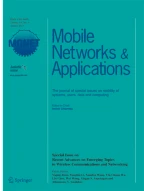Abstract
Enterprise wireless local area networks (WLANs) that consist of a high-density of hundreds to thousands of access points (APs) are being deployed rapidly in corporate offices and university campuses. The primary purpose of these deployments is to satisfy user demands for high bandwidth, mobility, and reliability. However, our recent study of two such WLANs showed that these networks are rarely used at their peak capacity, and the majority of their resources are frequently idle. In this paper, we bring to attention that a large fraction of idle WLAN resources results in significant energy losses. Thousands of WLANs world-wide collectively compound this problem, while raising serious concerns about the energy losses that will occur in the future. In response to this compelling problem, we propose the adoption of resource on-demand (RoD) strategies for WLANs. RoD strategies power on or off WLAN APs dynamically, based on the volume and location of user demand. As a specific solution, we propose SEAR, a practical and elegant RoD strategy for high-density WLANs. We implement SEAR on two wireless networks to show that SEAR is easy to integrate in current WLANs, while it ensures no adverse impact on end-user connectivity and performance. In our experiments, SEAR reduces power consumption to 46%. Using our results we discuss several interesting problems that open future directions of research in RoD WLANs.
Similar content being viewed by others
Notes
More statistics are located at http://www.itfacts.biz.
The MadWiFi device driver for Atheros chipset wireless cards allows devices to use an AP mode as well as a sniffing monitor mode to operate simultaneously over the same physical wireless interface.
Beacon messages are typically sent by APs at 100 ms intervals to announce their presence to the clients in the network.
From our experiments we find that requiring each AP to receive all 10 beacons from its neighbors is an overly strict requirement.
These values are similar to those presented in a recent study by Reiss et al. [18].
Note that a client in the WLAN is identified by the unique MAC address of its device’s wireless interface. As a result, devices with more than one wireless interface will be considered as more than one client.
Note that the “powering on or off” of the APs in our testbed means that the wireless interface of the device is activated and shutdown, respectively—and not the entire device itself. In operational WLANs, APs may be actually powered on or off to save energy.
References
Dartmouth College WLAN. http://crawdad.cs.dartmouth.edu
IEEE 802.11v: wireless network management. http://grouper.ieee.org/groups/802/11/Reports/tgv_update.htm
IETF CAPWAP WG: http://www.ietf.org/html.charters/capwap-charter.html
Aruba selected by microsoft for next generation wireless LAN (2005) http://www.arubanetworks.com/news/release/2005/06/13
Forrester research (2006) http://www.forrester.com
Bejerano Y (2002) Efficient integration of multi-hop wireless and wired networks with QoS constraints. In: ACM obicom, Atlanta, GA, September 2002
Chase JS, Anderson DC, Thakar PN, Vahdat A, Doyle RP (2001) Managing energy and server resources in hosting centres. In: SOSP, Banff, Canada, October 2001
Christensen KJ, Gunaratne C, Nordman B, George AD (2004) The next frontier for communications networks: power management. Comput Commun 27:1758–1770, June
Gupta M, Singh S (2003) Greening of the internet. In: ACM SIGCOMM, Karlsruhe, Germany, August 2003
Jardosh AP, Iannaccone G, Papagiannaki K, Vinnakota B (2007) Towards an energy-star WLAN infrastructure. In: HotMobile, Tucson, AZ, February 2007
Jardosh AP, Ramachandran KN, Almeroth KC, Belding EM (2005) Understanding link-layer behavior in highly congested IEEE 802.11b Wireless networks. In: Proceedings of ACM SIGCOMM workshop E-WIND, Philadelphia, PA, August 2005
Jardosh AP, Ramchandran KN, Almeroth KC, Belding EM (2005) Understanding congestion in IEEE 802.11b wireless networks. In: Proceedings of USENIX IMC, Berkeley, CA, October 2005
Kotz D, Henderson T, Abyzov I (2004) CRAWDAD trace set dartmouth/campus/snmp (v. 2004-11-09). Downloaded from http://crawdad.cs.dartmouth.edu/dartmouth/campus/snmp November 2004
Meka A, Singh AK (2006) Distributed spatial clustering in sensor networks. In: EDBT, Munich, Germany, March 2006
Mishra N, Chebrolu K, Raman B, Pathak A (2006) Wake-on-WLAN. In: ACM WWW, Edinburgh, UK, May 2006
Pinheiro E, Bianchini R, Dubnicki C (2006) Exploiting redundancy to conserve energy in storage systems (2006) In: Sigmetrics, Saint Malo, France, June 2006
Ramani I, Savage S (2005) SyncScan: practical fast handoff for 802.11 infrastructure networks. In: Proceedings of IEEE Infocom, Miami, FL, March 2005
Reis C, Mahajan R, Rodrig M, Wetherall D, Zahorjan J (2006) Measurement-based models of delivery and interference in static wireless networks. In: ACM Sigcomm, Pisa, Italy, September 2006
Rodrig M, Reis C, Mahajan R, Wetherall D, Zahorjan J (2005) Measurement-based characterization of 802.11 in a hotspot setting. In: Proceedings of EWIND, Philadelphia, PA, August 2005
Author information
Authors and Affiliations
Corresponding author
Rights and permissions
About this article
Cite this article
Jardosh, A.P., Papagiannaki, K., Belding, E.M. et al. Green WLANs: On-Demand WLAN Infrastructures. Mobile Netw Appl 14, 798–814 (2009). https://doi.org/10.1007/s11036-008-0123-8
Published:
Issue Date:
DOI: https://doi.org/10.1007/s11036-008-0123-8
